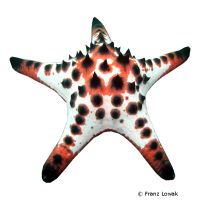Chocolate Chip Sea Star (Protoreaster nodosus)
| Chocolate Chip Sea Star Protoreaster nodosus | |
|---|---|
| Name | Chocolate Chip Sea Star |
| Name Lat. | Protoreaster nodosus |
| Family | Sea Stars |
| Family lat. | Oreasteridae |
| Order | Echinoderms |
| Order lat. | Valvatida |
| Origin | Indo-Pacific |
| Diet | Omnivore |
| pH | 8.1-8.4 |
| Hardness | 8-12 °KH |
| Lighting | Medium |
| Current | Moderate |
| Behavior | Semi-aggressive |
| Keeping | Individual |
| Care Level | Moderate |
| Life Span | N/A |
| Protection | No |
| Metric Units | |
| Size | 30 cm |
| Temperature | 24-26 °C |
| Salinity | 33-36 ‰ |
| Aquarium | 400 l |
| US Units | |
| Size | 12" |
| Temperature | 75-79 °F |
| Salinity | 1.020-1.025 sg |
| Aquarium | 100 gal |
Distribution and habitat
The range of Protoreaster nodosus extends from East Africa through Indonesia to Australia and Japan. They live mostly solitary in coral reefs with sandy or muddy bottoms and seagrass beds at depths of 3-20 m.
Maintenance
They require a well-structured aquarium with many free areas of sand or coral rubble. The equipment includes algae (e.g. Caulerpa) and sea grass as well as living stones, which act like a biological filter and with their porous structure provide settlement area and habitat for the purifying bacteria and microorganisms.
Only substrates rich in lime and free of heavy metals may be used as substrate. Filters, skimmers and heaters are necessary to ensure water quality, as well as pumps to simulate tides, swells and bottom currents. Lighting must match the species-appropriate day-night rhythm of the animals
| Salinity: 33-36 ‰ | pH value: 7.9-8.5 |
| Carbonate hardness: 6-10 °KH | Nitrate content: 2-8 mg/l |
| phosphate content: 0.01-0.1 mg/l | nitrite content: 0.0-0.05 mg/l |
Regular addition of trace elements, especially iodine, is recommended. For salinity, an average value should be aimed for, which may only vary slightly by +/- 0.5 ‰. Ammonia and ammonium must not be measurable. Special attention shall be paid to consistently good water quality and water values.
Diet
They feed on sponges, algae, detritus (dead organic material), anemones, gorgonians, soft corals, tubeworms, mussels, snails, sea urchins, etc., but also prey on other starfish and small sleeping fish. In addition to the food left over in a community tank, pieces of shrimp, mussels and fish meat should be fed once a week. For this purpose, hanging basins or feeding tongs have proven effective
Regular and varied feeding promotes health and increases resistance.
Behaviour and compatibility
Due to its feeding habits, socialization with lower animals and small fish is hardly possible. They should also not be kept with puffer fish. Unproblematic is the attitude in a pure fish aquarium with large animals.
Reproduction and breeding
They are separately sexual, but have no external sexual characteristics. The sexual products are released into the open water where fertilization occurs. Development occurs through several planktonic larval stages. Vegetative reproduction can occur, but is rare.
Important
Depending on their origin, they can be of different colors, such as red, yellowish, chocolate brown or blue.
Starfish should not be exposed to air. Air bubbles that form under the shell can cause deadly, bacterial diseases. They are very sensitive to a change in water quality (density, etc.)
For the necessary uniform supply of calcium carbonate and magnesium, a calcium reactor and a magnesium metering pump are recommended
If different species are kept together, care should be taken to ensure that fish and invertebrates match each other in terms of water quality and temperature requirements and social behavior, and that the setup meets the ecological needs of all species kept together. Newly introduced animals must be acclimated slowly to the water in the aquarium.
Further literature can be found in your pet store.
References
Text: petdata; Image: Franz Lowak
Source: MOOSLEITNER (1997): Meerwasser Atlas Bd. 3, Mergus Verlag; ENGELMANN & LANGE (2011): Zootierhaltung - Tiere in menschlicher Obhut: Wirbellose, Verlag Harri Deutsch
